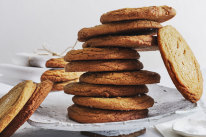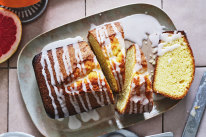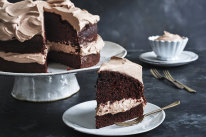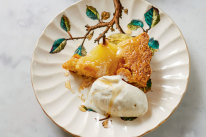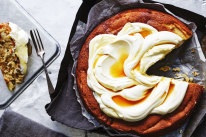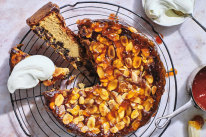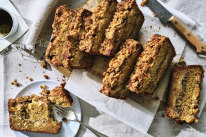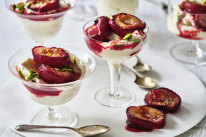Carpathian custard cake with choux pastry (aka eclair meets vanilla slice)
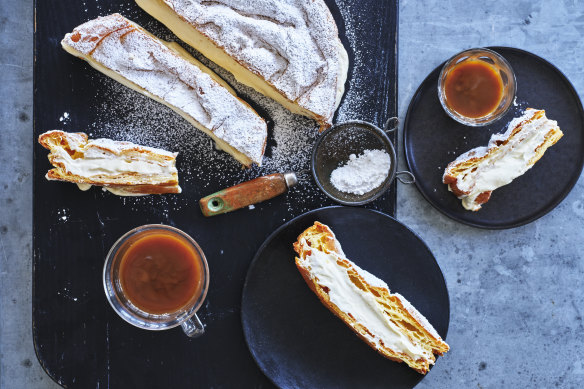
More commonly used to make eclairs and profiteroles, choux pastry is an easy and fun technique to master. This eclair cake from the Eastern European tradition uses two separately baked, deliberately uneven, pieces of choux pastry to sandwich a vanilla custard.
Its Polish name Karpatka hints at the craggy, snow-capped Carpathian mountains it’s said to resemble.
Ingredients
For the custard
150ml milk
80g caster sugar, divided
pared zest from 1 lemon
2 large egg yolks
30g cornflour
pinch of salt
seeds from ½ vanilla bean or 2 tsp vanilla extract
1 tbsp rosewater or rum (optional)
30g cold, unsalted butter, cut into small cubes
300ml pure cream, cold
icing sugar to dust
For the choux pastry
150ml water
50ml milk
100g unsalted butter, cut into cubes
1 tsp sugar
¾ tsp salt
100g plain flour, sifted twice
4 large eggs (200g net weight), lightly whisked
Method
Step 1
Begin by making the custard, which can be done a day ahead. Combine the milk, 40g of the sugar and the zest in a medium saucepan. Place over medium heat, stirring occasionally until it just begins to boil.
Step 2
Meanwhile, whisk the egg yolks, the remaining 40g of sugar, cornflour and salt in a medium bowl. When the milk is almost at boiling point – small bubbles will appear at the edge of the saucepan – remove from the heat and pour about a third of it over the yolks, whisking continuously. Add the remaining milk, whisk, then strain it back into the saucepan. Discard the lemon peel.
Step 3
Place the saucepan over medium heat and whisk continuously until it boils and thickens (about 5 minutes). Reduce the heat to low, add the vanilla and rosewater (if using), then the butter cubes. Whisk until melted and combined, then scrape the custard into a medium bowl. Press clingfilm directly onto the surface of the custard and set aside to cool in the fridge; it will be very thick for now.
Step 4
When you’re ready to make the pastry, grease and line the base and sides of a 20cm round cake tin with baking paper.
Step 5
Combine the water, milk, butter, sugar and salt in a medium saucepan. Place over low heat and allow the butter to gently melt. Once melted, increase the heat to medium high and, when it comes to a boil, add the flour all at once. Reduce the heat and stir vigorously with a wooden spoon to incorporate the flour. Continue to stir, until a smooth paste forms, which detaches from the sides of the pan (about 3 minutes).
Step 6
Transfer the paste to the bowl of a cake mixer and mix with the paddle attachment on low speed for 1 minute to cool it down. Add the eggs, about a quarter at a time, mixing well between each addition until the paste is smooth, shiny and sticky.
Step 7
Using two tablespoons, dollop about a third of the paste into the prepared cake tin, then link up the blobs with the back of the spoon so there are no gaps visible; this will form the thinner base layer of the cake. Don’t worry about making it absolutely perfect – remember you’re recreating the Carpathian Mountains! Place the cake tin in the fridge until you’re ready for it to go in the oven*. Cover the remaining two-thirds of the paste and put the bowl in the fridge, too (see note).
Step 8
Preheat the oven to 200C fan-forced (220C conventional). When the temperature has been reached, remove the tin from the fridge and place in the oven. Immediately reduce the temperature to 180C fan-forced (200C conventional) and bake for 35 minutes. Then reduce the temperature to 130C fan-forced (150C conventional) and continue to cook for another 15 minutes. The choux pastry layer will have risen unevenly and be a light golden-brown colour. When cool enough to handle, remove it from the tin and transfer to a cooling rack. Repeat the process with the remaining paste to form the thicker, top layer of the cake, increasing the baking time by 10 minutes at the end.
Step 9
Meanwhile, complete the custard filling by taking the cooled custard from the fridge and stirring to loosen it. Place the 300ml cold cream in the bowl of a cake mixer fitted with the whisk attachment and beat until soft peaks form. Fold the cream into the custard until fully combined.
Step 10
To serve, place the thinner pastry on a cake plate, and spread over the vanilla cream. Then place the second, thicker pastry on top. Dust liberally with icing sugar and serve.
*Note: You’re going to be baking the pastry in two separate batches (unless you have two 20cm cake tins, in which case you can bake them at the same time. However, the second layer requires a little extra time in the oven).
Appears in these collections
The best recipes from Australia's leading chefs straight to your inbox.
Sign up- More:
- Baking
- Cream & milk
- Eggs
- Dessert
- Slice
- Morning & afternoon tea
- Dinner party
- Eastern European
- French
- Mother's Day

